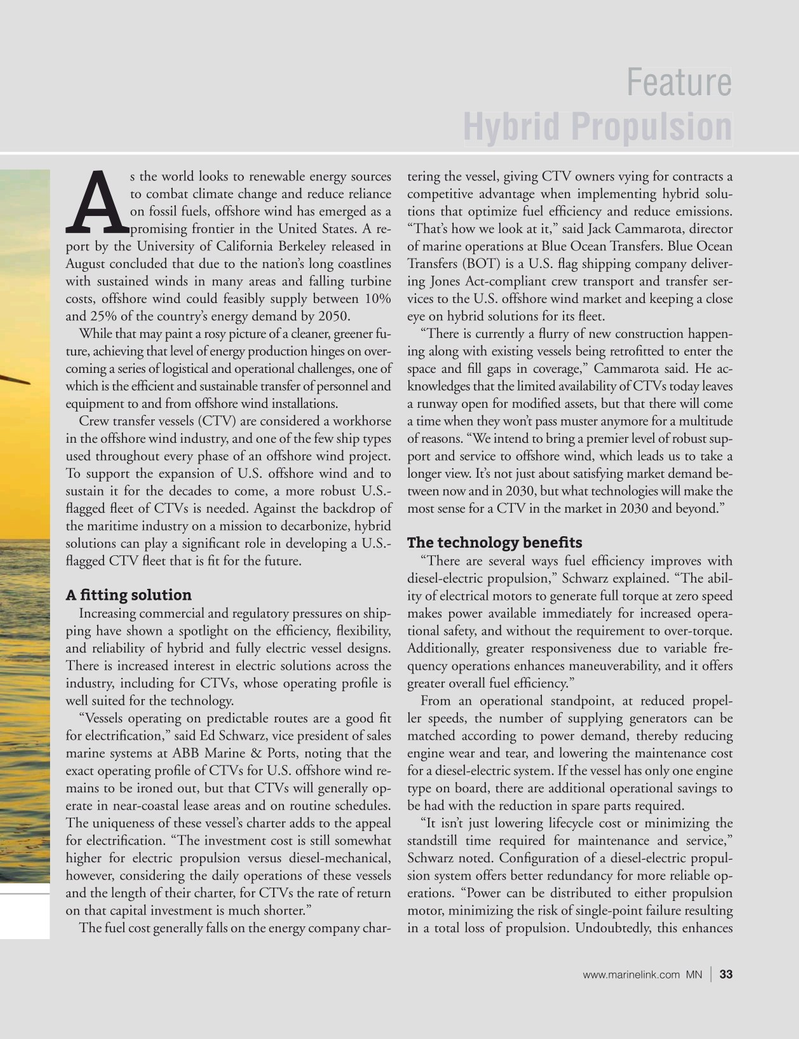
Page 33: of Marine News Magazine (November 2023)
Workboat Edition
Read this page in Pdf, Flash or Html5 edition of November 2023 Marine News Magazine
Feature
Hybrid Propulsion s the world looks to renewable energy sources tering the vessel, giving CTV owners vying for contracts a to combat climate change and reduce reliance competitive advantage when implementing hybrid solu- on fossil fuels, offshore wind has emerged as a tions that optimize fuel ef? ciency and reduce emissions. promising frontier in the United States. A re- “That’s how we look at it,” said Jack Cammarota, director
A port by the University of California Berkeley released in of marine operations at Blue Ocean Transfers. Blue Ocean
August concluded that due to the nation’s long coastlines Transfers (BOT) is a U.S. ? ag shipping company deliver- with sustained winds in many areas and falling turbine ing Jones Act-compliant crew transport and transfer ser- costs, offshore wind could feasibly supply between 10% vices to the U.S. offshore wind market and keeping a close and 25% of the country’s energy demand by 2050. eye on hybrid solutions for its ? eet.
While that may paint a rosy picture of a cleaner, greener fu- “There is currently a ? urry of new construction happen- ture, achieving that level of energy production hinges on over- ing along with existing vessels being retro? tted to enter the coming a series of logistical and operational challenges, one of space and ? ll gaps in coverage,” Cammarota said. He ac- which is the ef? cient and sustainable transfer of personnel and knowledges that the limited availability of CTVs today leaves equipment to and from offshore wind installations. a runway open for modi? ed assets, but that there will come
Crew transfer vessels (CTV) are considered a workhorse a time when they won’t pass muster anymore for a multitude in the offshore wind industry, and one of the few ship types of reasons. “We intend to bring a premier level of robust sup- used throughout every phase of an offshore wind project. port and service to offshore wind, which leads us to take a
To support the expansion of U.S. offshore wind and to longer view. It’s not just about satisfying market demand be- sustain it for the decades to come, a more robust U.S.- tween now and in 2030, but what technologies will make the ? agged ? eet of CTVs is needed. Against the backdrop of most sense for a CTV in the market in 2030 and beyond.” the maritime industry on a mission to decarbonize, hybrid solutions can play a signi? cant role in developing a U.S.- The technology bene? ts ? agged CTV ? eet that is ? t for the future. “There are several ways fuel ef? ciency improves with diesel-electric propulsion,” Schwarz explained. “The abil-
A ? tting solution ity of electrical motors to generate full torque at zero speed
Increasing commercial and regulatory pressures on ship- makes power available immediately for increased opera- ping have shown a spotlight on the ef? ciency, ? exibility, tional safety, and without the requirement to over-torque. and reliability of hybrid and fully electric vessel designs. Additionally, greater responsiveness due to variable fre-
There is increased interest in electric solutions across the quency operations enhances maneuverability, and it offers industry, including for CTVs, whose operating pro? le is greater overall fuel ef? ciency.” well suited for the technology. From an operational standpoint, at reduced propel- “Vessels operating on predictable routes are a good ? t ler speeds, the number of supplying generators can be for electri? cation,” said Ed Schwarz, vice president of sales matched according to power demand, thereby reducing marine systems at ABB Marine & Ports, noting that the engine wear and tear, and lowering the maintenance cost exact operating pro? le of CTVs for U.S. offshore wind re- for a diesel-electric system. If the vessel has only one engine mains to be ironed out, but that CTVs will generally op- type on board, there are additional operational savings to erate in near-coastal lease areas and on routine schedules. be had with the reduction in spare parts required.
The uniqueness of these vessel’s charter adds to the appeal “It isn’t just lowering lifecycle cost or minimizing the for electri? cation. “The investment cost is still somewhat standstill time required for maintenance and service,” higher for electric propulsion versus diesel-mechanical, Schwarz noted. Con? guration of a diesel-electric propul- however, considering the daily operations of these vessels sion system offers better redundancy for more reliable op- and the length of their charter, for CTVs the rate of return erations. “Power can be distributed to either propulsion on that capital investment is much shorter.” motor, minimizing the risk of single-point failure resulting
The fuel cost generally falls on the energy company char- in a total loss of propulsion. Undoubtedly, this enhances www.marinelink.com MN 33|

 32
32

 34
34
